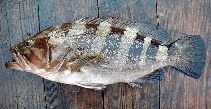| Family: |
Epinephelidae (Groupers) |
| Max. size: |
140 cm TL (male/unsexed) |
| Environment: |
demersal; marine; depth range 80 - 300 m |
| Distribution: |
Eastern Atlantic: Mauritania (Ref. 5377) and Senegal to southern Angola. |
| Diagnosis: |
Dorsal spines (total): 11-11; Dorsal soft rays (total): 16-16; Anal spines: 3-3; Anal soft rays: 8-8. Distinguished by the following characteristics: brownish head and body; 3-4 broad oblique bars on the dorsal part of the body and another on the dorsal half of the peduncle; 2 narrow faint dark bands extending posteriorly from the lower half of the eye; presence of dark moustache streak, not extending past the rear end on maxilla; body depth less than head length, depth contained 2.9-3.2 times in SL; head length 2.5-2.7 times in standard length; flat or slightly convex interorbital area; angular preopercle, 3-4 enlarged serrae at the angle, lowermost directed ventrally; serrate interopercle and subopercle; well developed middle and lower opercular spines, upper spine not apparent; approximately straight upper edge of operculum; maxilla reaches vertical at rear edge of eye; maxilla naked or with few minute scales dorsally; 2 rows of teeth on midlateral part of lower jaw; posterior nostril about twice the size of anterior nostril (Ref. 89707). |
| Biology: |
Reported to occur from a variety of habitats (rock, mud and sand). The adults live in relatively deeper waters (Ref. 5377). Little is known about its biology. |
| IUCN Red List Status: |
Near Threatened (NT); Date assessed: 15 July 2017 (A2bd) Ref. (130435)
|
| Threat to humans: |
harmless |
| Country info: |
|
Source and more info: www.fishbase.org. For personal, classroom, and other internal use only. Not for publication.

